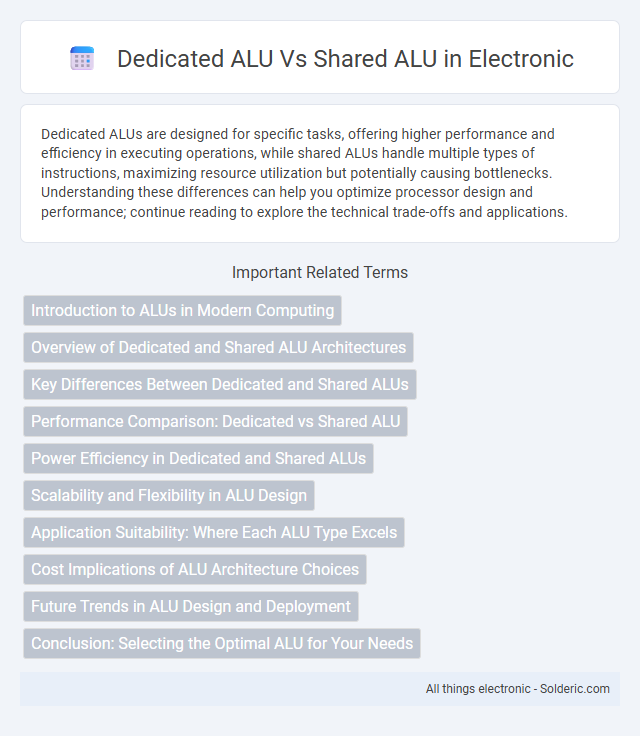Dedicated ALUs are designed for specific tasks, offering higher performance and efficiency in executing operations, while shared ALUs handle multiple types of instructions, maximizing resource utilization but potentially causing bottlenecks. Understanding these differences can help you optimize processor design and performance; continue reading to explore the technical trade-offs and applications.
Comparison Table
| Feature | Dedicated ALU | Shared ALU |
|---|---|---|
| Definition | ALU assigned to specific tasks or units | Single ALU used by multiple tasks or units |
| Performance | High, due to parallel execution | Lower, due to resource contention |
| Hardware Cost | Higher, requires multiple ALUs | Lower, fewer ALU units needed |
| Complexity | Increased design complexity | Simpler hardware design |
| Power Consumption | Higher power usage | More power-efficient |
| Use Case | High-performance CPUs, parallel processing | Embedded systems, cost-sensitive designs |
Introduction to ALUs in Modern Computing
Arithmetic Logic Units (ALUs) are fundamental components within processors, responsible for executing arithmetic and logical operations crucial to modern computing tasks. Dedicated ALUs are specialized units designed for specific operations, enhancing performance by minimizing latency in tasks such as integer addition or bitwise logic, while shared ALUs handle multiple operation types through time-sharing, optimizing resource utilization and reducing hardware complexity. Understanding the balance between dedicated and shared ALU configurations aids in designing processors that meet diverse performance and efficiency requirements across computing applications.
Overview of Dedicated and Shared ALU Architectures
Dedicated ALU architectures feature individual arithmetic logic units assigned to specific processing tasks, enabling parallel execution and reducing latency for critical operations. Shared ALU architectures utilize a single arithmetic logic unit across multiple operations or cores, optimizing resource utilization and minimizing hardware costs but potentially introducing contention and delays. Trade-offs between these architectures influence system performance, energy efficiency, and complexity in microprocessor and digital signal processing designs.
Key Differences Between Dedicated and Shared ALUs
Dedicated ALUs perform specific arithmetic or logic operations within a processor, offering faster execution and optimized performance for particular tasks by isolating resources. Shared ALUs are utilized by multiple processes or instructions, maximizing hardware resource efficiency but potentially causing contention and slower execution due to multiplexing. The primary difference lies in resource allocation and performance trade-offs: dedicated ALUs provide speed and specialization, while shared ALUs enhance hardware utilization at the expense of possible latency.
Performance Comparison: Dedicated vs Shared ALU
Dedicated ALUs offer superior performance by executing specific arithmetic or logic operations in parallel, reducing latency and increasing throughput for targeted tasks. Shared ALUs, while cost-effective and area-efficient, may introduce bottlenecks due to resource contention when multiple operations require access simultaneously. To optimize Your system's computational efficiency, choosing dedicated ALUs is advantageous for high-performance applications demanding rapid and concurrent processing.
Power Efficiency in Dedicated and Shared ALUs
Dedicated ALUs improve power efficiency by executing specific arithmetic operations with optimized circuits, reducing redundant switching activity and minimizing power consumption. Shared ALUs, while offering hardware resource savings, often consume more power due to increased multiplexing and control logic overhead, which leads to higher switching activity. Your design choice impacts power efficiency significantly, with dedicated ALUs favoring low-power applications where specific operations dominate.
Scalability and Flexibility in ALU Design
Dedicated ALU designs offer high performance for specialized operations by optimizing hardware resources, but they often lack scalability and flexibility when adapting to diverse workloads. Shared ALU architectures enhance scalability by allowing multiple processing units to access common arithmetic logic, improving resource utilization and supporting a broader range of tasks. Balancing dedicated and shared ALU components enables efficient scaling and flexible computing, vital for modern heterogeneous computing systems.
Application Suitability: Where Each ALU Type Excels
Dedicated ALUs excel in real-time systems and specialized applications such as digital signal processing and graphics rendering, where high-speed, specific arithmetic operations are crucial. Shared ALUs are more suitable for general-purpose computing environments like CPUs and multitasking systems, offering flexibility and efficient resource utilization by handling varied instruction sets dynamically. Your choice depends on the application's performance demands and complexity, with dedicated ALUs optimizing speed for fixed tasks and shared ALUs balancing versatility and cost.
Cost Implications of ALU Architecture Choices
Dedicated ALUs increase hardware costs due to their exclusive functionality, requiring more silicon area and power consumption compared to shared ALUs. Shared ALUs reduce overall system cost by maximizing resource utilization, allowing multiple operations to leverage a single arithmetic logic unit. However, shared ALUs may introduce latency and complexity in scheduling operations, potentially impacting performance efficiency.
Future Trends in ALU Design and Deployment
Future trends in ALU design emphasize increased specialization, with dedicated ALUs tailored for specific tasks like AI inference or cryptographic operations to boost performance and energy efficiency. Shared ALUs, while more flexible and cost-effective for general-purpose computing, may face limitations in handling highly parallel or domain-specific workloads. Your systems can benefit from hybrid architectures that combine dedicated and shared ALUs to optimize throughput and adaptability in emerging applications such as machine learning and edge computing.
Conclusion: Selecting the Optimal ALU for Your Needs
Selecting the optimal ALU depends on your specific application requirements and performance goals. Dedicated ALUs provide higher efficiency and faster execution for specialized tasks, while shared ALUs offer greater flexibility and resource savings in multi-functional processors. Your choice should balance speed, complexity, and resource availability to maximize overall system performance.
dedicated ALU vs shared ALU Infographic

 solderic.com
solderic.com